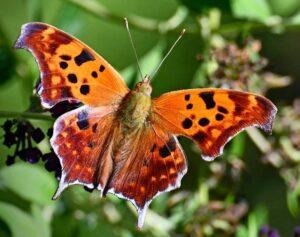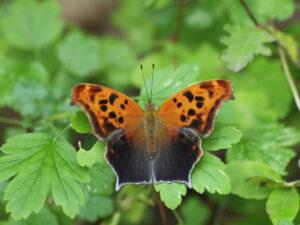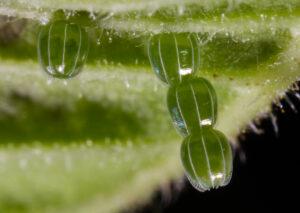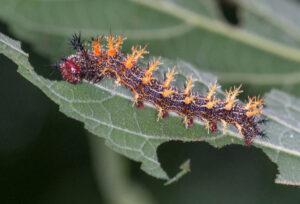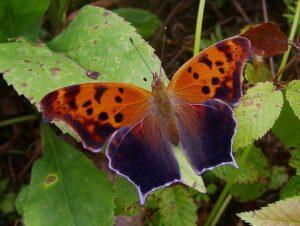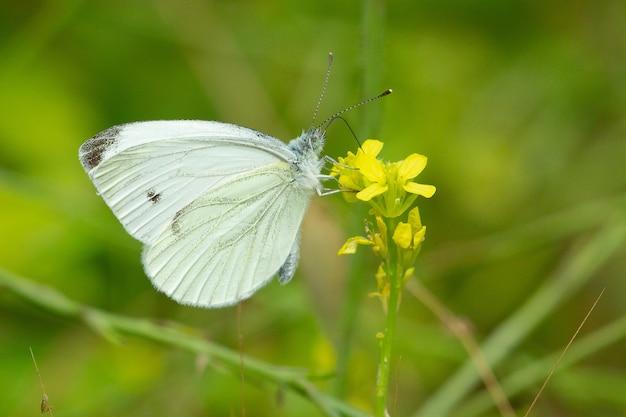Question Mark Butterfly (Polygonia interrogationis)
Updated on
28/10/2022The question mark butterfly is a common medium-sized butterfly in suburban and wooded areas. The silver mark on the ventral side of the hindwing is divided into a curved line and a dot resembling a question mark ‘?’. Hence its common name. It is considered one of the largest butterflies in its range and is most active in the early mornings and late afternoons.
Scientific Classification
- Class:Insecta
- Order:Lepidoptera
- Family:Nymphalidae
- Genus:Polygonia
- Species:P. interrogationis
Conservation Status
Description
In keeping with the other species of its genus, there are many angles to the outline of its wings. When its wings are folded, it resembles a dead leaf that helps it camouflage.The color and textured appearance of its wings’ ventral side help achieve the end.
When unfurled, the borders of its wings are powdery white. The forewings are orange with black spots. The upper part of the hindwings is black in summer and orange in winter. The wingspan is 1.8-3 inches (4.5-7.6 cm).
Distribution: Eastern United States, southern Canada, and central Mexico
Habitat: Swamps, moist woodlands, city parks, and residential landscapes that have a combination of open spaces and trees.
Do They Bite/Sting: No
Lifespan: The adults live for around 6-20 days.
Predators:Tachinid fly parasitoids
Behavior and Characteristics
Diet
The adult butterfly seeks tree sap, rotting fruit, carrion, or dung for its food. Only when the said food sources are unavailable does the butterfly turns to flowers for nectar. This dietary adaptation sees it through overwintering, late and early spring, when nectar sources become limited.
Nest-building
These butterflies build their nests close to each other on non-host plants.They cover their nests with dead leaves.
Life Cycle
The insect passes through 4 stages of its life. They are egg, larva (caterpillar), pupa, and adult.
1. Egg Stage
The eggs can be laid singly or in stacks under the leaves of plants that are not usually the hosts. The hatchlings need to find their own food to survive.The egg stage in this butterfly’s lifecycle lasts 4-14 days.
2. Caterpillar Stage
The caterpillar is 1.4 in (3.6 cm) in length and develops in a series of steps called instars. Towards the end of each instar, the larva’s cuticle (the hard outer layer of its skin) is released from the soft tissue under it, and a new cuticle layer starts forming. At the end of an instar, the old cuticle is shed, and the newer one expands, quickly hardens, and develops pigments. The last instar sees the start of the wing pattern development. The larval stage of the question mark lasts for 3-4 weeks.
The caterpillars feed on different host plants, mainly American elm, hackberry, red elm, nettles, false nettle, and Japanese hop.
3. Pupa Stage
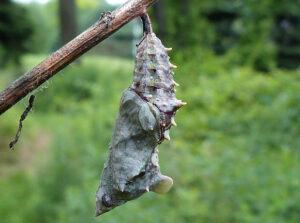
Once the last instar is over, the caterpillar enters the pupal stage with no protective layer or cocoon to cover it.Near the end of this chrysalis stage, it molts, becoming soft and fleshy,and exhibits many developing features of the future butterflythat can only be revealed on close observation. Then it hardens and gets colors matching its surroundings to help camouflage. After around a couple of weeks, the adult butterfly comes out in the morning or afternoon. The chrysalis stage lasts for 7-18 days.
4. Adult Stage
Sexual dimorphism is absent in the adult question mark. When the male finds a female perched on grass or a tree, courting starts, followed by mating. The female flies and lays eggs in spring till the end of May. The summer adults come out and fly from May-September laying eggs that turn into the winter form of the butterfly. The winter adults emerge in late August and spend the winter in different shelters.
Comparison with Similar Species
Comma Butterfly
The comma butterfly has a silver or white mark resembling a comma on its hindwing without the extra dot below it,as is characteristic of the question mark butterfly.
FAQs
The question mark butterfly signifies spiritual birth, a deep connection with the soul, and transformations.
Source
birdsandblooms.com, cdn.butterflyatlas.org, i.pinimg.com, lh3.ggpht.com, roadsendnaturalist.files.wordpress.com,




